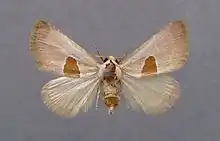Calymma
Calymma is a monotypic moth genus of the family Erebidae erected by Jacob Hübner in 1823. Its single species, Calymma communimacula, was first described by Michael Denis and Ignaz Schiffermüller in 1775.[1][2] It is found in central and southern Europe and from Turkey to Transcaucasia and the Middle East.
| Calymma | |
|---|---|
 | |
| Scientific classification | |
| Domain: | Eukaryota |
| Kingdom: | Animalia |
| Phylum: | Arthropoda |
| Class: | Insecta |
| Order: | Lepidoptera |
| Superfamily: | Noctuoidea |
| Family: | Erebidae |
| Genus: | Calymma Hübner, [1823] |
| Species: | C. communimacula |
| Binomial name | |
| Calymma communimacula (Denis & Schiffermüller, 1775) | |
| Synonyms | |
|
Generic
Specific
| |
The wingspan is 18–24 mm. Adults are on wing from July to August.
The larvae live on trees, but do not feed on plant material, but suck dry Coccoidea (scale insects) and use the empty hulls as a protective shelter. Pupation takes place in a spinning on the tree trunk.
Taxonomy
The genus has previously been classified in the subfamily Eublemminae of Erebidae or the subfamily Acontiinae of the family Noctuidae.[3]
References
Wikimedia Commons has media related to Calymma.
Wikispecies has information related to Calymma.
- Savela, Markku (12 February 2012). "Calymma Hübner, [1823]". Lepidoptera and Some Other Life Forms. Retrieved 17 November 2019.
- "Calymma communimacula (Denis & Schiffermüller, 1775)". Fauna Europaea. Retrieved 17 November 2019.
- "Eublemminae". Fauna Europaea. Archived from the original on December 19, 2013. Retrieved 26 November 2014.
External links
- Pitkin, Brian & Jenkins, Paul. "Search results Family: Arctiidae". Butterflies and Moths of the World. Natural History Museum, London.
- Moths and Butterflies of Europe and North Africa
- Lepiforum e.V.
This article is issued from Wikipedia. The text is licensed under Creative Commons - Attribution - Sharealike. Additional terms may apply for the media files.